
Scan QR code
Structure: three-dimensional structure
Color: green, black, dark green
Height: 50-300mm (national standard/non-standard)
Welding distance: 300-1000mm
Material: Smooth embossed and perforated flat plate, non perforated
Sheet thickness: (flat smooth sheet) 1-1.2mm (embossed sheet) 1.3-1.5mm
Tensile yield strength: ≥ 20Mpa
Weld tensile strength: ≥ 100-142 (N/CM)
Customization:
Various specifications, height, welding distance, color, etc. can be processed and customized according to customer requirements
Function:
Environmental protection, slope protection, greening, road construction, soil consolidation, and foundation strengthening
To prevent the topsoil from sliding downwards, the permeable holes of the grid sheet can effectively seep through, reduce the gravity of the water body, and the vegetation roots in the grid are intertwined to form a strong anchoring force, effectively protecting the topsoil and resisting water erosion.
Geocell is a three-dimensional mesh cell structure formed by high-strength HDPE material and high-strength welding. It can expand and retract freely, can be folded during transportation, opened during use, and filled with materials such as sand, gravel, or soil in the cell, forming a structure with strong lateral limitations and high stiffness. It can be used as a cushion layer to enhance the bearing capacity of weak foundations, or laid on slopes to form slope protection structures. It can also be used to construct support structures, making construction convenient and fast.
Stable performance and strong adaptability
Light material, wear-resistant, stable chemical properties, light aging resistance, acid and alkali resistance, suitable for different soil and desert geological conditions
High tensile strength and strong bearing capacity
The tensile strength of the material and weld seam is high. The high lateral limit and anti slip deformation effectively enhance the bearing capacity of the roadbed and disperse the load
Strong erosion resistance, anti slip, anti deformation
Corrosion resistant, with high bearing capacity and good dynamic performance, strong erosion resistance, and good soil consolidation effect High flexibility and good slope stability
It can replace slope materials such as concrete and asphalt blocks, with good stability and beautiful greening effect
Geometric dimensions, convenient construction, customizable
Geometric dimensions to meet different engineering needs. Flexible and retractable, with small transportation volume; The main accessories are overlapped, efficient and convenient, and the construction speed is fast
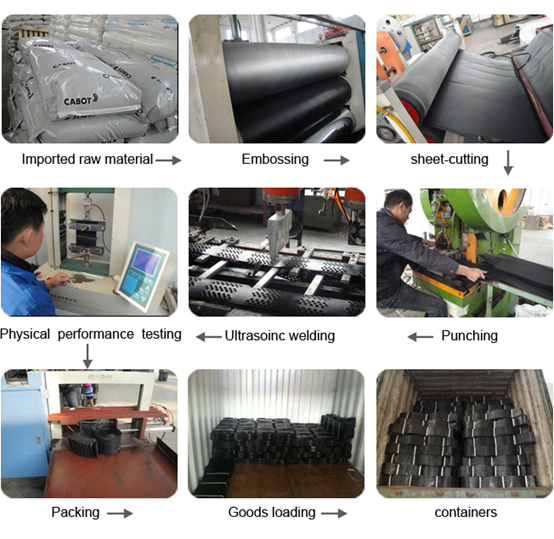
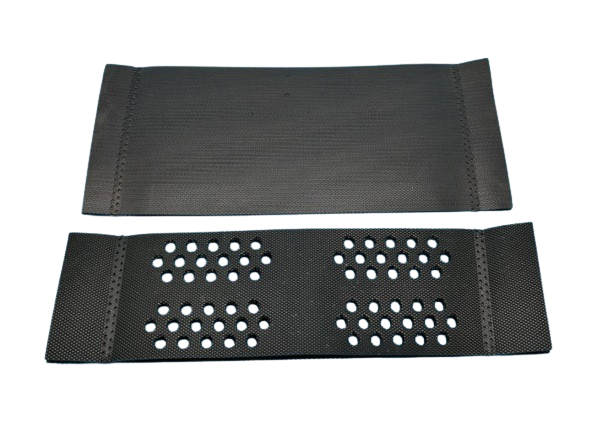
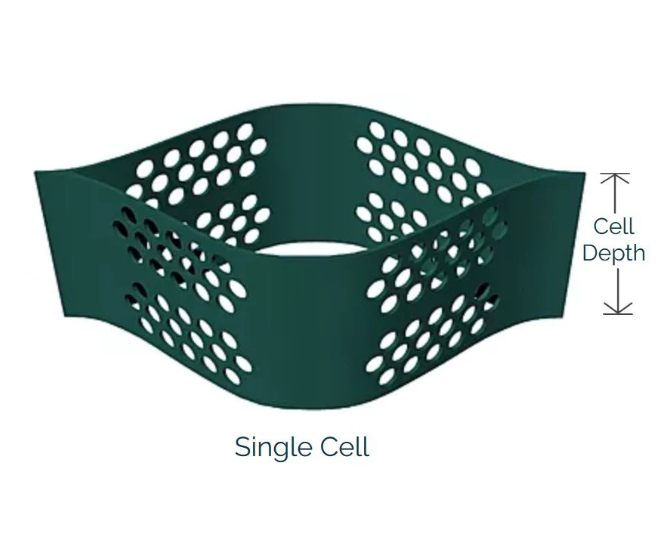
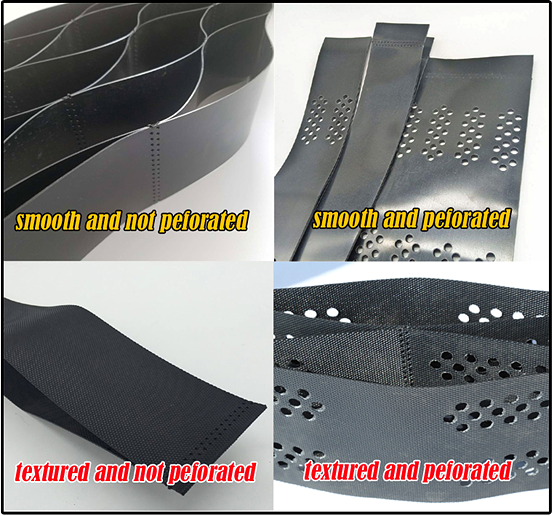

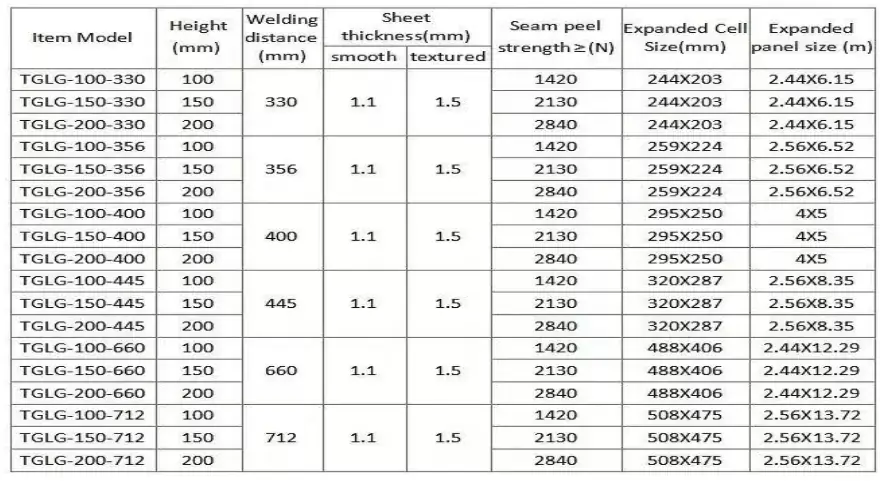
Geocell reinforcement of foundation is a mechanical soil reinforcement method that does not change the particle composition and interconnectivity of the filling material. Geogrids are mainly reinforced through interactions, which mainly include three aspects: the lateral constraint effect of the geogrid, the mesh effect of the geogrid, and the frictional effect of the geogrid.
The lateral constraint effect of the geocell is mainly reflected in two aspects: firstly, the frictional effect of the geocell on the soil outside the cell; The second is the clamping effect of the geocell on the soil within the grid element. The geotechnical cell provides a significant lateral constraint on the filling material, and the side walls of the cell generate upward frictional support force on the filling material, forming a composite with high flexural and tensile stiffness and shear strength. This complex can isolate the transmission of stress and displacement, thereby enabling flexible transition and coordinating the settlement of the top surface of the semi filled and semi excavated roadbed. Moreover, it has a net pocket effect on local loads, making the distribution of loads more uniform.
The frictional effect of the geocell is mainly reflected in the interface between the filler and the cell wall. The frictional force partially transfers the vertical load to the geocell, and then partially outward from the geocell. Through this transfer, the foundation pressure is reduced, thereby improving the bearing capacity of the cushion layer and reducing foundation settlement and uneven settlement.
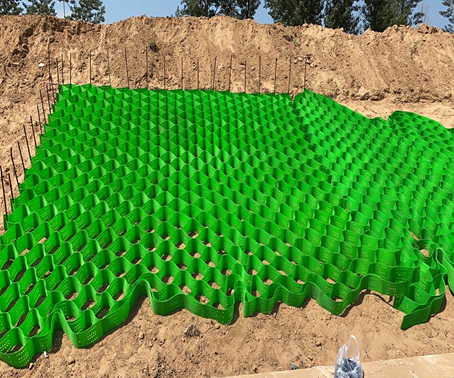
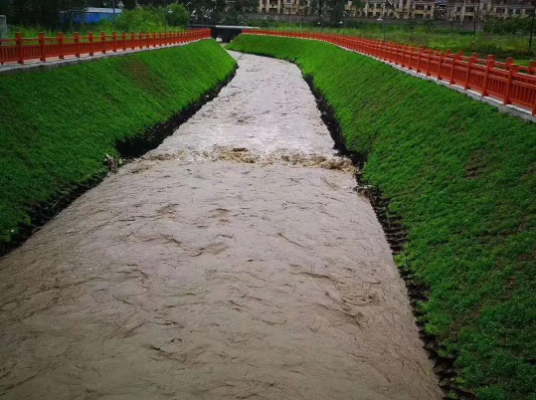
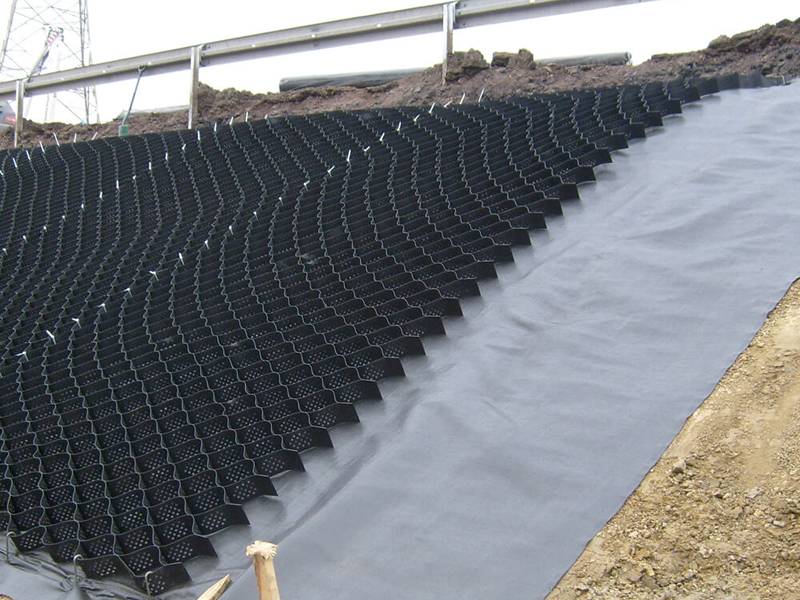
1. Soft foundation treatment for railways and highways, used for foundation reinforcement.
2. Engineering construction of deserts, beaches, river beds, and landfill sites.
3. Large scale projects such as water conservancy and municipal landscaping, used for soil and water conservation and landscaping.
4. Embankments and shallow river management, retaining walls, used to enhance load-bearing capacity and prevent landslides.
5. It has a good effect in dealing with semi filled and semi filled roadbed, roadbed in windy and sandy areas, roadbed reinforcement in abutment back, roadbed in permafrost areas, loess collapsible roadbed, saline soil, expansive soil, etc.
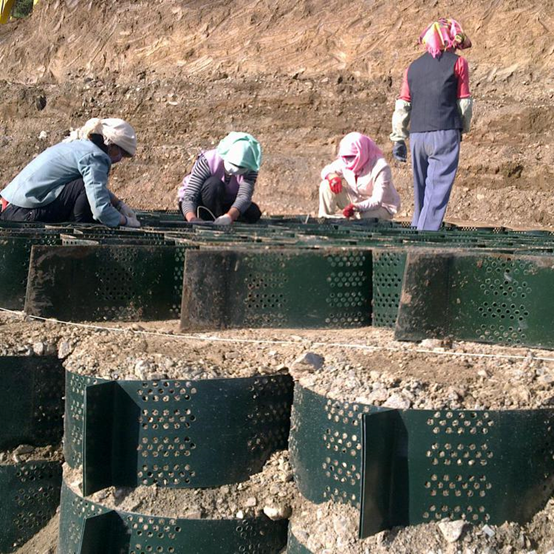
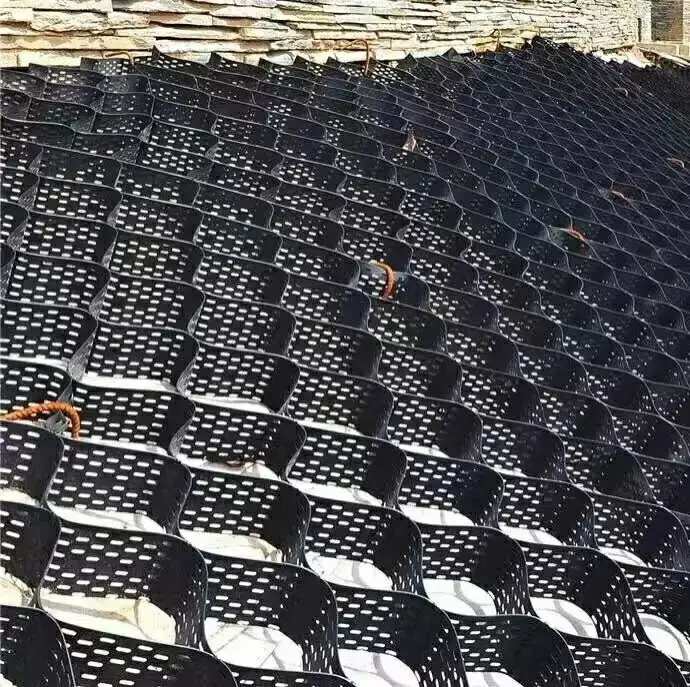
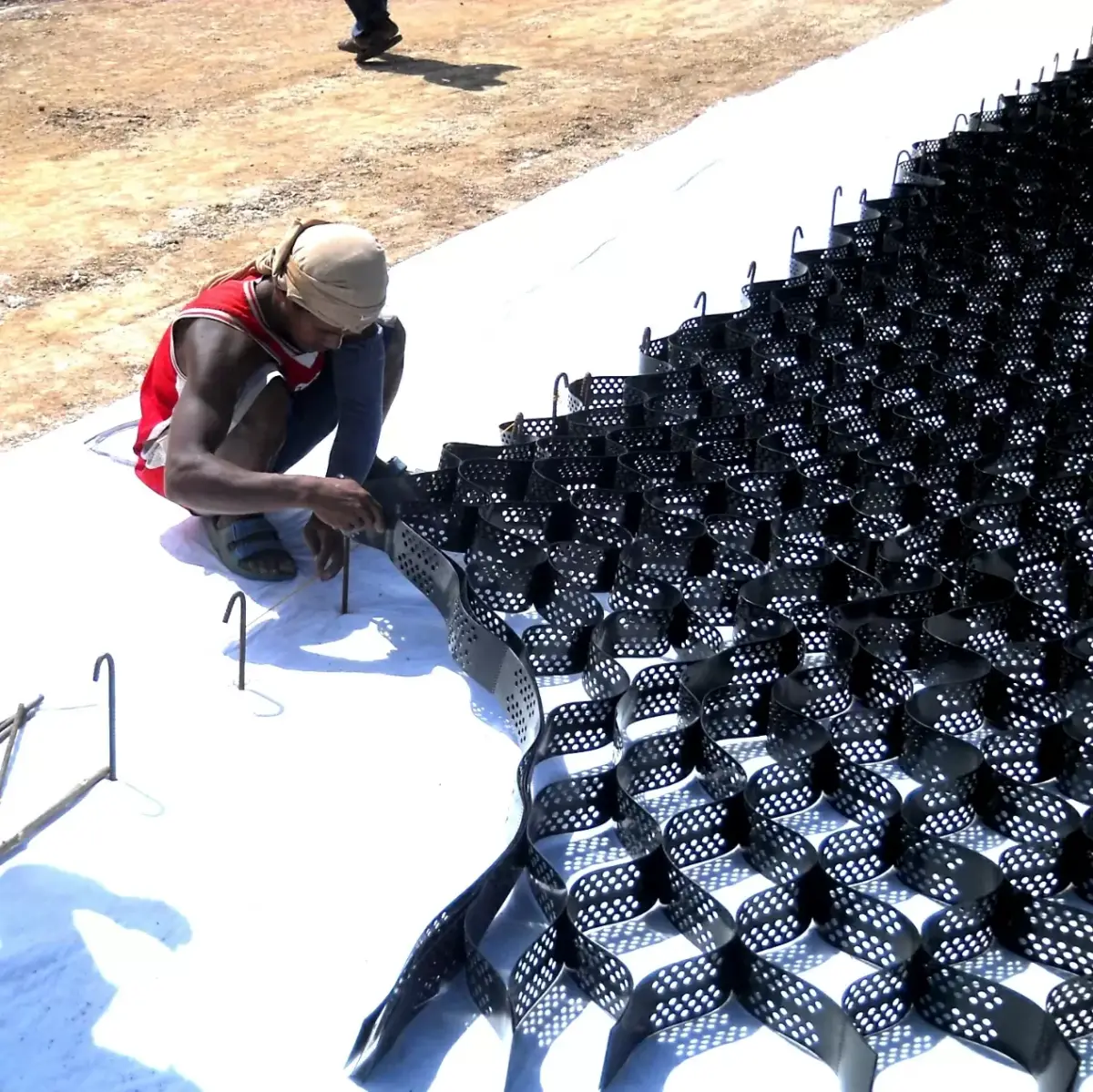
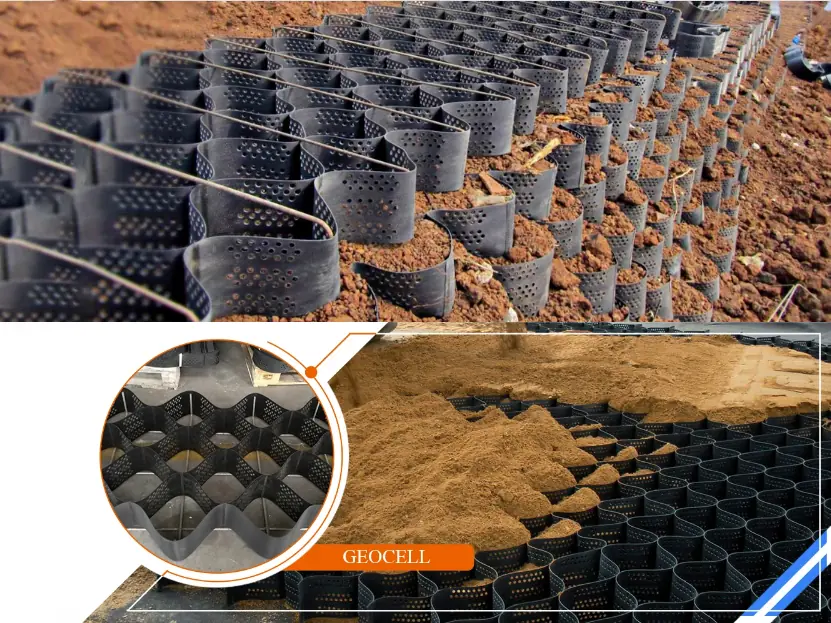

1. Leveling the site
(1) Clean the filling and excavation joint surface according to the drawing requirements, ensuring the width and flatness of this joint surface;
(2) When the ground is uneven, the joint surface should be leveled or a thin layer of filler should be filled for leveling.
2. Laying of high-strength geotextile cell
(1) Laying method:
a. At the intersection of horizontal filling and excavation, one layer is laid on the base, and one layer is laid on the ground and top surface of the roadbed. The end is anchored within the excavation steps for no less than 2m, and the entire width of the roadbed is laid horizontally.
b. At the intersection of longitudinal filling and excavation, the geogrid chamber is laid in two layers, with the lower layer set at the bottom of the roadbed and the upper layer set at the top of the roadbed. The geocell is anchored within less than 5m of the excavated roadbed and less than 10m of the filled roadbed
(2) Open the cell, connect the starting end with anchor nails coated with anti rust paint, and anchor it in the filled roadbed not less than 60cm. According to the area of the geotechnical cell, increase the anchoring density in the middle if necessary.
(3) By adopting a horizontal laying method, the width of each cell corresponds to the width of the embankment. As the lateral strength of the cells is consistent, it is sufficient to maintain a horizontal position during laying.
(4) By adding weight (referring to the filling of soil in the grid of the edge cell) or anchoring nails, the cell is positioned in a plane and does not move due to the filling.
(5) Before laying the soil, check the cell for any damage. If any, the compartment should be replaced immediately.
(6) Lay the geocell and fill it with soil.
3. Filling and backfilling
(1) The laying of high-strength geotextile cells should not have any looseness, and they should be manually tightened before filling;
(2) The construction adopts machinery that is suitable for the foundation conditions, and the grounding force is not allowed to be too large;
(3) Use a rear tilting truck to unload soil along the edge of the cell, manually cooperate with a bulldozer to level the soil, or use an excavator to fill the cell. The height of soil falling should not exceed 1 meter
4. Rolling and leveling
(1) Pay attention to the weight of the rolling machinery and use construction machinery that is suitable for the foundation situation;
(2) Determine the thickness of the fill soil based on the foundation condition, generally not less than 40cm;
(3) It can be compacted with a flat roller.
Connection fixation method:
Connection method: The honeycomb cell sub and sub buckle connectors are made by punching 2-4 1 cm circular holes outside the weld seam, and the sub and sub buckles are used for multi-point connection. The connection strength is greater than the welding strength of the sheet material, and zero distance connection is achieved without displacement between the two cells and affecting the overall stability of the honeycomb constraint system. They are currently the preferred connection method used for honeycomb cell connections. In addition, plastic ties and iron wires can also be used for connection.
Fixing method: The fixed limit element also solves the problem of insufficient constraint on the anchor rod due to the short cap body of the original anchor rod cap, and the weak control of the sheet material due to the short clamping arm, which is easy to slip. The combination of the limit element and the threaded anchor rod is more scientific, and the limit effect on the honeycomb cell is stronger. During the paving process, U-shaped steel bars or wooden piles should be used for fixation. The depth of the fixed parts into the soil should be 15-20cm to ensure their stability and firmness, and then the cells should be unfolded and sprayed.
Attention: The edge of the cell needs to be fixed first before unfolding, especially when laying from top to bottom during steep slope construction, the top cell needs to be fixed first before unfolding downwards. Some slope surfaces are not flat, with stones and potholes that need to be leveled and treated before construction can proceed. When laying honeycomb geocells on slopes, it is necessary to use a top-down approach, especially for river slopes. If necessary, geotextile should be used for pre laying to increase the permeability of the laying layer.
Accessories recommendation: The mother and son buckle is a complete set of accessories, with higher integrity and strength than connectors such as ties and wire. The first push is the mother and son buckle connection. And the accessories are very cheap, which can ensure the connection strength and protect the overall continuity of the cell unit.
Previous : Honeycomb geocell
Next:Geocell
Hot Keywords:GeocellGeogridGeotexileGeocompositeGeomatGeomembrance